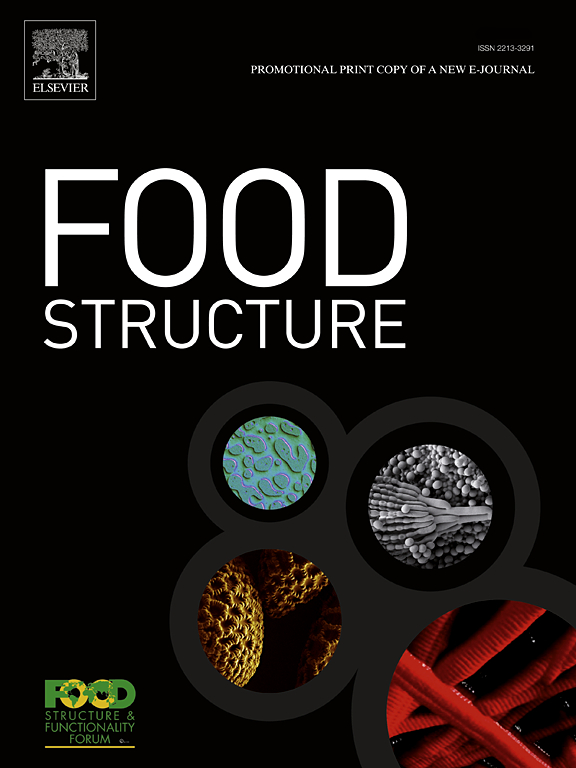Enhancing pore structure and nutritional quality of microwave-vacuum dried carrots with pulsed electric fields
IF 5.9
3区 农林科学
Q1 FOOD SCIENCE & TECHNOLOGY
引用次数: 0
Abstract
The development of porous structure in food materials is crucial for enhancing functional properties, such as rehydration and bioactive compound retention. Despite advancements, the influence of processing parameters on physical structure and the combined effects of multiple techniques remains under-explored. The aim of this paper is to investigate the impact of varying pulsed electric fields (PEF) energy inputs on the physical and functional properties of microwave-vacuum dried carrots. Carrots were pre-treated by PEF with the specific energy inputs of 0.5, 1.0, and 2.0 kJ/kg, at a field intensity of 1.07 kV/cm; a control group remained untreated. Carrots were sliced into 4 mm, blanched, frozen, and microwave-vacuum dried. The quality of dried material was assessed through total carotenoid content, antioxidant activity by ABTS assay, total phenolic content, rehydration rate, hygroscopicity, scanning electron microscopy, and micro-computed tomography. It was found that PEF-treated samples exhibited a more uniform distribution of pores compared to the untreated group. The rehydration rate of the untreated samples was 32 % lower than the 2.0 kJ/kg PEF-treated samples, while 1.0 kJ/kg PEF-treated samples demonstrated higher hygroscopicity. Furthermore, the study showed that 2.0 kJ/kg PEF-treated carrots had the highest carotenoid content. However, no significant benefits were observed from PEF treatment in improving antioxidant activity or polyphenol content, with 2.0 kJ/kg PEF-treated carrots showing the lowest levels of both. These results highlight the potential of PEF as a pre-treatment to improve the structural and functional quality of dried food products, offering new possibilities for the development of advanced porous food materials.
脉冲电场增强微波真空干燥胡萝卜的孔隙结构和营养品质
多孔结构的发展对于提高食品材料的功能特性,如补液和生物活性化合物的保留至关重要。尽管取得了进步,但加工参数对物理结构的影响以及多种技术的综合效应仍未得到充分探索。本文的目的是研究不同脉冲电场(PEF)能量输入对微波真空干燥胡萝卜物理和功能特性的影响。采用比能输入分别为0.5、1.0和2.0 kJ/kg的PEF预处理胡萝卜,场强为1.07 kV/cm;对照组不接受治疗。胡萝卜切成4 毫米,焯水,冷冻,微波真空干燥。通过类胡萝卜素总含量、ABTS抗氧化活性、总酚含量、再水化率、吸湿性、扫描电镜和显微计算机断层扫描等指标来评价干燥材料的质量。研究发现,pef处理的样品比未处理的样品具有更均匀的孔隙分布。未处理样品的再水化率比2.0 kJ/kg pef处理样品低32 %,而1.0 kJ/kg pef处理样品的吸湿性更高。此外,研究表明2.0 kJ/kg pef处理的胡萝卜类胡萝卜素含量最高。然而,PEF处理在提高抗氧化活性或多酚含量方面没有显著的益处,2.0 kJ/kg PEF处理的胡萝卜在这两方面的水平最低。这些结果突出了PEF作为一种改善干燥食品结构和功能质量的预处理方法的潜力,为开发先进的多孔食品材料提供了新的可能性。
本文章由计算机程序翻译,如有差异,请以英文原文为准。
求助全文
约1分钟内获得全文
求助全文
来源期刊

Food Structure-Netherlands
Chemical Engineering-Bioengineering
CiteScore
7.20
自引率
0.00%
发文量
48
期刊介绍:
Food Structure is the premier international forum devoted to the publication of high-quality original research on food structure. The focus of this journal is on food structure in the context of its relationship with molecular composition, processing and macroscopic properties (e.g., shelf stability, sensory properties, etc.). Manuscripts that only report qualitative findings and micrographs and that lack sound hypothesis-driven, quantitative structure-function research are not accepted. Significance of the research findings for the food science community and/or industry must also be highlighted.
 求助内容:
求助内容: 应助结果提醒方式:
应助结果提醒方式:


